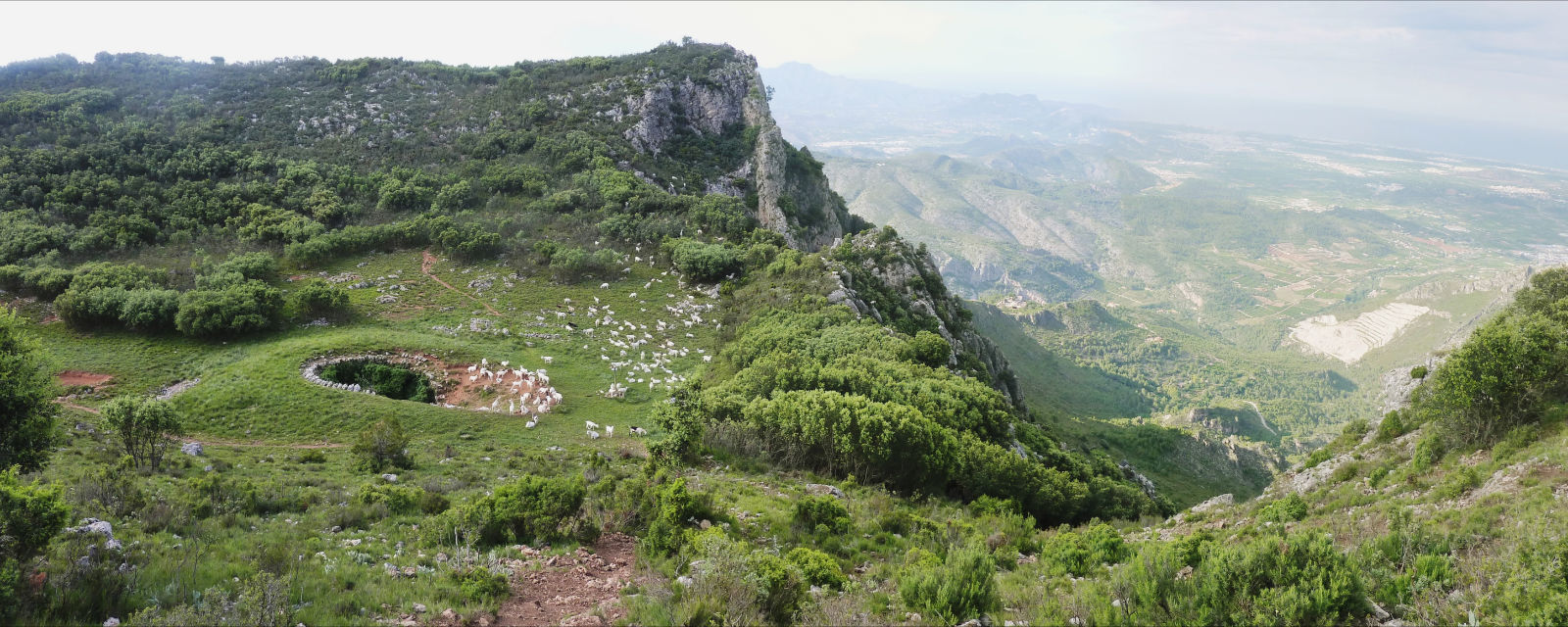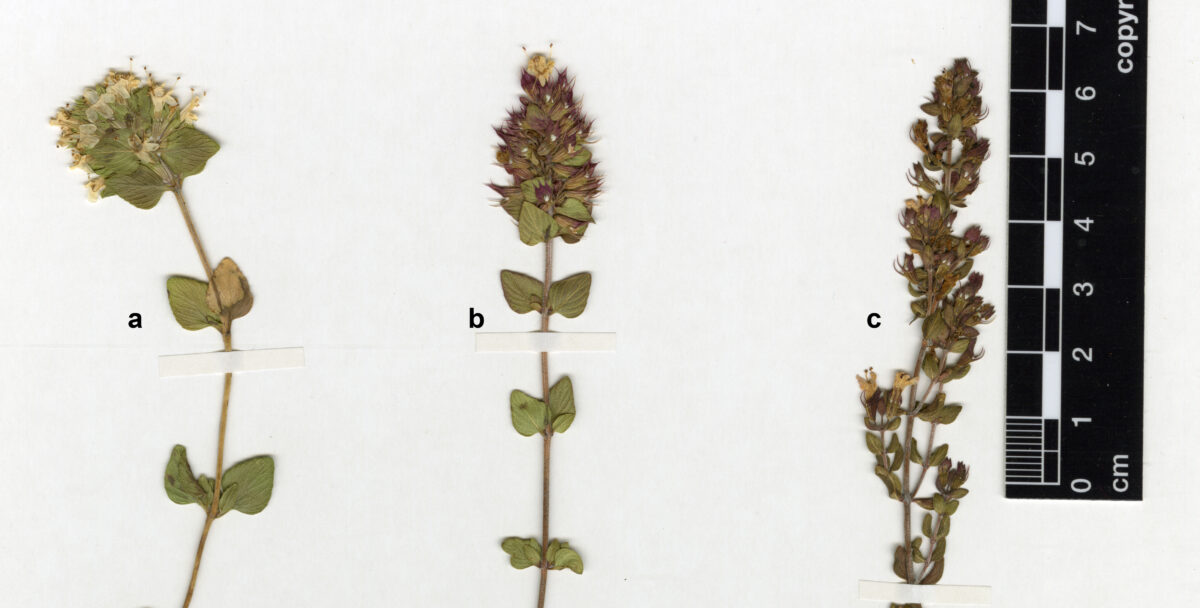A new Valencian thyme hybrid

Researchers at the Jardí Botànic of the Universitat de València have discovered a new hybrid of the genus Thymus L. (Lamiaceae) from the eastern Iberian Peninsula. Specimens from this endemic Valencian thyme hybrid, Thymus × bolosii, were found in four different places of the “Sierra de la Safor”, between Valencia and Alicante. The conclusions of the research have been published in the journal “Flora Montiberica”
The parental species of the new thyme hybrid are Thymus richardii subsp. vigoi Riera, Güemes & Rosselló and Thymus piperella L., both endemic species from the East of Spain, although the former is only known in the “Sierra de la Safor”, while the latter has a much wider distribution, reaching Murcia and Albacete. Even so, the new hybrid “had different characteristics since they were collected in the natural environment. Especially in their inflorescence, which is not as long as, for example, that of the thyme. (Th. Piperella), nor as compact as that of Th. Richardii subsp. Vigoi, although it is more similar to the second one”, explains Jesús Riera, the curator of the herbarium of the Jardí Botànic of the Universitat de València and co-author of the work, together with Jaime Güemes and Josep Antoni Rosselló.

Hermabrium sheet of the hybrid Thymus × bolosii. Picture: Herbarium of the Jardí Botànic of the Universitat de València.
The new hybridogenous species has been named Thymus x bolosii, after the prestigious Catalan botanist Oriol de Bolòs i Capdevila (1924-2007). He is an expert of the Valencian flora and the author of Flora dels Països Catalans, among a wide range of other books.
Hybridization, the origin of new species
Plant hybridization is a relatively common process and often produces fertile offspring and lead to the formation of a new species. It is an evolutionary process that has been present in most of the origin of the Mediterranean flora and is still active, making it possible to observe speciation processes today. However, hybridization “can pose risks for the survival of parent plants, when hybrid populations increase, surpassing the original species”, state researchers of the Jardí Botànic.
In this case, the expansion of the Thymus x bolosii hybrid is believed to have higher impact on Thymus richardii subsp. vigoi. For this reason, “it is essential to collect seeds of that species, for its preservation in the Jardí Botànic’s Germplasm Bank. This way we have genetic material to plan possible population reinforcements in order to increase the number of reproductive individuals of the endangered species”, says Riera.

Detailed image of the inflorescences of: a) Thymus richardii subsp. vigoi (VAL-185407); b)Th. x bolosii (VAL-185512); c) Th. piperella (VAL-105771). Picture: Herbarium of the Jardí Botànic of the Universitat de València.
Hybridization can also pose a risk for native flora, if one of the parents is an exotic species, usually coming from gardens or poorly-planned landscape restoration. Nonetheless, this is not the case studied by the Botànic researchers. “Hybridization with Thymus genus is very frequent in contact zone between two species. In the Iberian Peninsula, more than a hundred thyme hybrids have been found and described, and only about 50 species and subspecies are known”, explains Jaime Güemes, director of the Jardí Botànic.
“In many cases, thyme hybrid is sterile and their presence is limited to the first generation. We have not yet carried out a study of the biology of the previously described species, then we cannot venture to say whether its population will expand, nor whether it will be able to crossbreed with its parents”, adds Güemes.
Reference centre for botanical research
Research work on the genus Thymus began almost three decades ago, after Professor Josep Antoni Roselló, who had been working in the Real Jadín Botánico, joined the Universitat de València. The distribution centre of Thymus richardii is made up of the western Mediterranean islands. It is diversified into four subspecies, one of them in Mallorca, another in Ibiza, another in the small island of Marettino, near Sicily, and finally, the only exclusively continental subspecies, endemic to the Sierra de la Safor.

The specimens of the genus Thymus were found in four areas of the Serra de la Safor. Picture: Blog ‘A un tir de pedra‘.
Thymus richardii subsp. Vigoi –discovered and described in 2007 by the team made up of Riera, Güemes and Rosselló– confirmed the presence of this species in the Iberian Peninsula, where it had not been seen since the 1950s. The comparative study of the material collected by the Botànic team, led to the description of a new subspecies, that is different from the island species in their leaves, cordate at the base and denticulated at the margin. This finding was also published in Flora Montiberica.
The distribution of species in the Mediterranean is not uniform and has some unique disjunctions. Thus, subsp. Richardii is found in Mallorca and some areas of the Balkan Peninsula. The rest shows very reduced areas with few populations, such as those on the island of Marettino (subsp. nitidus), Ibiza (subsp. ebusitanus) or La Safor (subsp. vigoi).
Findings of the Valencian flora like this, shown the importance of university research in the contribution to the scientific knowledge of biodiversity. The Jardí Botànic of the Universitat de València is the main botanical research centre of the Valencian Community. Its Herbarium gives support to the studies on Valencian flora and its Germplasm Bank save seeds of the most endangered Valencian species. Researchers study the flora to complete the catalogue of Valencia plant diversity.









